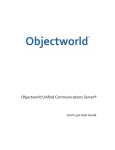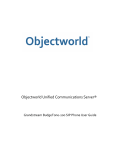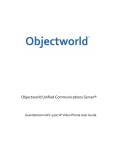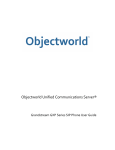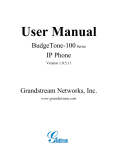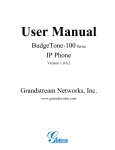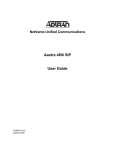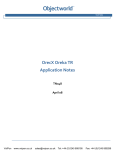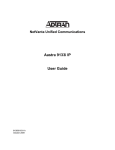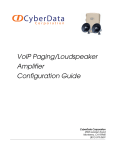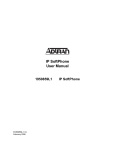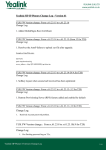Download NetVanta UC Server 4.5 Grandstream_BT-100 User Manual
Transcript
Objectworld Unified Communications Server® Grandstream BudgeTone‐100 Series IP Phone User Guide © 2001-2009 Objectworld Communications Corp. All rights reserved. Published February 18, 2009 Objectworld, Objectworld Unified Communications Server, Objectworld UC Server, Objectworld UC Client, Objectworld Connect, Objectworld Connect PLUS, IT Telephony, and The IT Telephony Company are either trademarks or registered trademarks of Objectworld Communications Corp. in the United States and/or other countries. All other trademarks or registered trademarks are property of their respective owners. Part No. UCS-1011-000-v4.4 Table of Contents 1 Grandstream BudgeTone-100 SIP Phone Overview . . . . . . . . . . . . . 1 Overview . . . . . . . . . . . . . . . . . . . . . . . . . . . . . . . . . . . . . . . . . . . . . . . . . . . . . . . . . . . . . . 1 Display Features . . . . . . . . . . . . . . . . . . . . . . . . . . . . . . . . . . . . . . . . . . . . . . . . . . . . . . . . 1 Key Descriptions . . . . . . . . . . . . . . . . . . . . . . . . . . . . . . . . . . . . . . . . . . . . . . . . . . . . . . . . 3 2 Using BudgeTone-100 Features . . . . . . . . . . . . . . . . . . . . . . . . . . . . . 5 Using the BT100 Call Feature Access Codes . . . . . . . . . . . . . . . . . . . . . . . . . . . . . . . . . 5 Making Calls . . . . . . . . . . . . . . . . . . . . . . . . . . . . . . . . . . . . . . . . . . . . . . . . . . . . . . . . . . . 7 Answering Calls . . . . . . . . . . . . . . . . . . . . . . . . . . . . . . . . . . . . . . . . . . . . . . . . . . . . . . . . 9 Holding and Resuming Calls . . . . . . . . . . . . . . . . . . . . . . . . . . . . . . . . . . . . . . . . . . . . . 10 Muting and Unmuting Calls . . . . . . . . . . . . . . . . . . . . . . . . . . . . . . . . . . . . . . . . . . . . . . 11 Conferencing . . . . . . . . . . . . . . . . . . . . . . . . . . . . . . . . . . . . . . . . . . . . . . . . . . . . . . . . . 11 Transferring Calls . . . . . . . . . . . . . . . . . . . . . . . . . . . . . . . . . . . . . . . . . . . . . . . . . . . . . . 12 Ending Calls . . . . . . . . . . . . . . . . . . . . . . . . . . . . . . . . . . . . . . . . . . . . . . . . . . . . . . . . . . 13 Redialing . . . . . . . . . . . . . . . . . . . . . . . . . . . . . . . . . . . . . . . . . . . . . . . . . . . . . . . . . . . . . 13 Forwarding Calls . . . . . . . . . . . . . . . . . . . . . . . . . . . . . . . . . . . . . . . . . . . . . . . . . . . . . . . 13 Changing the Volume . . . . . . . . . . . . . . . . . . . . . . . . . . . . . . . . . . . . . . . . . . . . . . . . . . . 14 Selecting a Ring Tone . . . . . . . . . . . . . . . . . . . . . . . . . . . . . . . . . . . . . . . . . . . . . . . . . . 14 Accessing Call Lists . . . . . . . . . . . . . . . . . . . . . . . . . . . . . . . . . . . . . . . . . . . . . . . . . . . . 15 Accessing Voice Mail . . . . . . . . . . . . . . . . . . . . . . . . . . . . . . . . . . . . . . . . . . . . . . . . . . . 15 3 Using UC Server Features . . . . . . . . . . . . . . . . . . . . . . . . . . . . . . . . . 17 Using the UC Server Call Feature Access Codes . . . . . . . . . . . . . . . . . . . . . . . . . . . . . Parking Calls and Picking up Parked Calls . . . . . . . . . . . . . . . . . . . . . . . . . . . . . . . . . . . Picking up Calls Ringing at Another Extension . . . . . . . . . . . . . . . . . . . . . . . . . . . . . . . . Using the UC Server Conference Bridge . . . . . . . . . . . . . . . . . . . . . . . . . . . . . . . . . . . . Queuing Calls . . . . . . . . . . . . . . . . . . . . . . . . . . . . . . . . . . . . . . . . . . . . . . . . . . . . . . . . . Paging . . . . . . . . . . . . . . . . . . . . . . . . . . . . . . . . . . . . . . . . . . . . . . . . . . . . . . . . . . . . . . 17 20 21 22 23 25 1 Grandstream BudgeTone-100 SIP Phone Overview This document is designed to outline the features and functions of the Grandstream BudgeTone-100 SIP in relation to the Objectworld Unified Communications Server™. This chapter covers the following topics: • Overview • Key Descriptions • Display Features 1.1 Overview This document is not intended to replace the Grandstream BudgeTone-100 SIP Phone User Manual. For more detailed information about the product, particularly its operation in the absence of UC Server, please refer to the Grandstream User Manual. NOTE: For information on using your telephone mailbox see the Quick Reference Card available on the Objectworld web site at www.objectworld.com/support/documentation. 1.2 Display Features The BT-100 phone has a numeric LCD of 64 mm x 24 mm size with backlight. This model has a small, red LED status reminder. Here is the display when all segments illuminate: Objectworld Unified Communications Server 1 1 Grandstream BudgeTone-100 SIP Phone Overview When the phone is in the normal idle state, the backlight is off. When a call occurs, the backlight and the red LED turns on automatically to bring to the user’s attention. In addition, if Voice Mail is configured and there is a voice mail message waiting, the backlight will be blinking and the red LED message light lights up to remind users there is a voice mail in the Voice Mail server. Icon LCD Icon Definitions Network Status Icon Off – IP address or SIP server is not found On – IP address and SIP server are located Flash – Ethernet link failure or the phone is not registered properly Phone Status Icon Off – When the handset is on-hook On – When the handset is off-hook /Headset Speakerphone Status Icon Flash – When phone rings Off – When the speakerphone/headset is off On – When the speakerphone/headset is on Handset and Speakerphone / Headset Volume Icon 0-7 scales to adjust handset / speakerphone volume Real–time Clock Synchronized to Internet time server Time zone configurable via web browser Call Logs 01-10 for CALLED history (dialed number) 01-10 for CALLERS history (Incoming caller ID) Time Icon AM for the morning PM for the afternoon IP Address Separator Icon 2 Objectworld Unified Communications Server Key Descriptions Icon LCD Icon Definitions Numerical Numbers and Characters: 0-9 *=+ #=+ A, b, C, c, d, E, F, G, g, H, h, I, L, n, O, o, P, q, r, S, t, U, u, Y 1.3 Key Descriptions Key Button Key Button Definitions 0 - 9, *, # Digit, star and pound keys are usually used to make phone calls Objectworld Unified Communications Server 3 1 Grandstream BudgeTone-100 SIP Phone Overview Key Button Key Button Definitions 1. Reduce handset, speakerphone/headset volume after off hook the phone via handset or speaker 2. Reduce ring tone volume when phone in IDLE and off hook to confirm the changed ring tone volume 3. Next menu item browsing when phone is in IDLE mode after MENU key pressed, off hook to interrupt and exit 1. Increase handset, speakerphone/headset volume after off hook the phone via handset or speaker 2. Increase ring tone volume when phone in IDLE and off hook to confirm the changed ring tone volume 3. Previous menu item browsing when phone is in IDLE mode after MENU key pressed, off hook to interrupt and exit MENU Enter keypad MENU mode when phone is in IDLE mode. It is also the ENTER key once entering MENU CALLED After off hook, press to display the dialed numbers. When number displayed, pressing the SEND key can make call using that displayed number. CALLERS After off hook, press to display the incoming Caller IDs. When number displayed, pressing the SEND key can make call using that displayed number. MESSAGE Enter to retrieve voice mails from Voice Mail Portal or Server HOLD Temporarily hold the active call TRANSFER Transfer the active call to another party CONFERENCE Establish 3-way conferencing call FLASH Flash event to switch between two lines MUTE/DEL Mute an active call; or Delete a key entry, call log etcetera . SEND /(RE)DIAL Dial a new number entered or Redial the number last dialed. After entering the phone number, pressing this key forces a call to go out immediately before timeout. SPEAKER Enter hands-free mode using the speakerphone 4 Objectworld Unified Communications Server 2 Using BudgeTone-100 Features This chapter outlines the features that are available on the Grandstream BudgeTone100 SIP telephone. UC Server supports all the telephone features that are outlined in this chapter, unless otherwise noted. For more information on the BT100 keys see: UC Server supports the following main features of the Grandstream BudgeTone-100 SIP listed below, unless otherwise noted. • • • • • • • • • • • • • • Using the BT100 Call Feature Access Codes Making Calls Answering Calls Holding and Resuming Calls Muting and Unmuting Calls Conferencing Transferring Calls Ending Calls Redialing Forwarding Calls Changing the Volume Selecting a Ring Tone Accessing Call Lists Accessing Voice Mail 2.1 Using the BT100 Call Feature Access Codes To access various call features, key press sequences are provided by the BudgeTone100 phone. NOTE: The Grandstream feature access codes listed below are disabled by default, due to a conflict with one of the UC Server feature access codes. Therefore, the codes below will only work if the system administrator has enabled the Grandstream feature access codes. Objectworld Unified Communications Server 5 2 Using BudgeTone-100 Features The table below shows the available call features of BudgeTone 100 by using keypad star(*) code, if the VoIP service provider supports these call features in the server side. The BT100 phone supports a number of call features including: • Block Caller ID (or Anonymous Call) • Call Waiting (Disable/Enable) • Call Forwarding all Calls, when Busy, or when Delayed BT100 Call Features Key Codes Examples and Notes Block Caller ID (for all config change) *30 Send Caller ID (for all config change) *31 Block Caller ID (per call) *67 Send Caller ID (per call) *82 Disable Call Waiting (for all config change) *50 Enable Call Waiting (for all config change) *51 Disable Call Waiting (per Call) *70 Enable Call Waiting (per Call) *71 Forward all Calls Forwards all calls unconditionally. *72 + Forward Number + SEND To forward all calls to extension 300: 1. Dial: *72 2. At the dial tone, dial: 300 3. Press SEND 4. At the dial tone, hang up. Cancel Forwarding all Calls Cancels forwarding all calls unconditionally. *73 1. Dial: *73 2. At the dial tone, hang up. 6 Note: This feature code conflicts with the Call Queuing feature code of UC Server. Therefore, your system administrator may have changed the Send Caller ID feature code number. See your system administrator for more information. Objectworld Unified Communications Server Making Calls BT100 Call Features Key Codes Examples and Notes Forward Calls when Busy *90 + Forward Number + SEND To forward calls when busy to extension 300: 1. Dial: *90 2. At the dial tone, dial: 300 3. Press SEND 4. At the dial tone, hang up. Cancel Forwarding Calls when Busy *91 1. Dial: *91 2. At the dial tone, hang up. Forward Calls when Delayed *92 + Forward Number + SEND To forward calls when delayed to extension 300: 1. Dial: *92 2. At the dial tone, dial: 300 3. Press SEND 4. At the dial tone, hang up. Cancel Forwarding Calls when Delayed *93 1. Dial: *93 2. At the dial tone, hang up. When in conversation, this actions switches Flash or to the new incoming call if the user hears the Hook Flash call waiting sound. When in conversation and there is no other incoming call, this actions switches to a new channel for a new call. 2.2 Making Calls For information on making calls, see the following sections: • Handset, speakerphone and headset mode • Making a call using a phone number • Making a call using an IP address Handset, speakerphone and headset mode Handset mode and Speakerphone/Headset mode cannot be enabled at the same time. Objectworld Unified Communications Server 7 2 Using BudgeTone-100 Features To switch between Handset and Speakerphone/Headset Speakerphone status icon • Press the hook-switch or SPEAKER button to toggle the phone between these two modes. • Making a call using a phone number There are several ways to make phone calls: To make a call • Pick up the handset or press the SPEAKER button, and then enter the phone number. TIP: If you make a mistake dialing a number, press MUTE/DEL to delete the last digit entered. Other methods of placing calls are: • Press the SEND button to redial the last number called. Once pressed, the last dialed number is displayed on the LCD as the corresponding DTMF tones are played out and an outgoing call is sent. • Browse the CALLED/CALLER history and press the SEND/REDIAL button. Pick up the handset or press the SPEAKER button, then press the CALLED/ CALLERS button to browse through the last 10 numbers dialed. Once the desired number is identified and displayed on the LCD screen, press the SEND button and a new call to that displayed number is sent out immediately. Examples: • To dial another extension on the same proxy, such as 1008, pick up the handset or press SPEAKER, dial 1008 and then press the SEND button. • To dial a PSTN number such as 6266667890, you might need to enter in some prefix number followed by the phone number. Check with your VoIP service provider to get the information. If you phone is assigned with a PSTN-like number such as 6265556789, most likely you follow the rule to dial 16266667890 as if you were calling from a regular analog phone, followed by pressing the SEND button. 8 Objectworld Unified Communications Server Answering Calls Making a call using an IP address Direct IP calling allows two parties, that is, a BudgeTone phone and another VoIP device, to talk to each other in an ad hoc fashion without a SIP proxy. This kind of VoIP call can be made between two parties if: • Both the BudgeTone phone and other VoIP Device (that is, another IP Phone or BudgeTone SIP phone or other VoIP unit) have public IP addresses, or • Both the BudgeTone phone and other VoIP Device are on the same LAN using private or public IP addresses, or • Both the BudgeTone phone and other VoIP Device can be connected through a router using public or private IP addresses (with necessary port forwarding or DMZ). To make a direct IP to IP call 1 With the phone off hook, press the MENU key. 2 Enter a 12-digit target IP address to make the call. 3 If the port is not the default 5060, then destination ports can be specified by using “*4” (encoding for “:”) followed by the port number. Examples: • If the target IP address is 192.168.0.10, the dialing convention is MENU_key 192 168 000 010 followed by pressing the SEND key or wait for seconds in the No Key Entry Timeout. • If the target IP address/port is 192.168.1.20:5062, then the dialing convention would be: MENU_key 192168001020*45062 followed by pressing the SEND key wait for seconds in the No Key Entry Timeout. 2.3 Answering Calls NOTE: To forward an incoming call directly to voice mail, press MUTE/ DEL to reject the call and forward it to voice mail. To answer a call • Pick up the handset to answer the call normally. TIP: Alternatively, press the SPEAKER button to answer a call in either speakerphone or headset mode. Objectworld Unified Communications Server 9 2 Using BudgeTone-100 Features Using call waiting to answer a call If call waiting is enabled, then while you are on a call, you will hear a stutter tone if there is another incoming call. To answer an incoming call while on another call 1 Press the FLASH button to put the current caller on hold and switch to the other call. 2 Press the FLASH button again to toggle between two active calls. 2.4 Holding and Resuming Calls To place a call on hold • While on a call, press the Hold button to put the remote end on hold. To resume a call on hold • Press the Hold button again to release the previous Hold state and resume the call. To park a call at a selected park number 1 Put the current call on hold. NOTE: If your phone has more than one identity assigned to it, then Transfer the call instead of putting it on hold. 2 Dial *99. 3 Enter the number that you want to use as the park number. The hold position is used by the person who answers the parked call. For example, if you enter 1234, then the call is parked at 1234, and can be picked up at 1234. 4 Press DIAL. The call is removed from the hold position, and put in the park position. To answer a parked call 1 Typically, a company announcement informs you that a call is on hold for you. 2 Dial *98. The system prompts you for the park hold position. 3 Dial the number of the park hold position. The system disconnects the current call and presents a new call. 10 Objectworld Unified Communications Server Muting and Unmuting Calls 4 Answer the new call to speak to the parked caller. NOTE: If nobody answers the parked call, the call rings the extension that originally put the call on system park. 2.5 Muting and Unmuting Calls You can mute an active call so that the other party cannot hear you. To mute a call 1 Press MUTE/DEL to mute a call. 2 Press MUTE/DEL again to resume the conversation. NOTE: When dialing a number, pressing MUTE/DEL deletes the last digit entered. Pressing MUTE/DEL can also be used to delete a call log. 2.6 Conferencing The BudgeTone 100 phone supports a 3-way conference. Follow the instructions below if you are on a call with one party, and you wish to bring a second party into the call as a conference call. To initiate a conference call 1 Press the CONFERENCE button. This puts the first party on hold and gets a dial tone. 2 Dial the number for the second party, and then press SEND to make the call. 3 If the second party answers the call, then press the CONFERENCE button to bring both parties into the conference. 4 If the second party does not answer the call, then press FLASH to resume the call with the first party. NOTE: During the conference, if either party drops the call, then the remaining two parties can continue talking. However, if the conference initiator hangs up, then all calls are terminated. NOTE: For information on the UC Server conference bridge see “Using the UC Server Conference Bridge” on page 22. Objectworld Unified Communications Server 11 2 Using BudgeTone-100 Features 2.7 Transferring Calls Two transfer operations are supported, blind and attended transfers. Blind Transfer Transfers an active call to a third party without announcing the call. Attended Transfer Transfers an active call to a third party with an announcement. To transfer a call blindly 1 Press the TRANSFER button. If the other voice channel is available (that is, there is no other active conversation besides the current one), you will hear a dial tone. 2 Dial the third party’s phone number then press SEND. NOTE: The Enable Call Feature has to be configured to Yes in the Web configuration page in order to make this feature work. You can hold on to the phone and wait for one of the three following behaviors: • A quick confirmation tone (temporarily using the call waiting indication tone) followed by a dial tone. This indicates the transfer was successful. You can hang up or make another call. • A quick busy tone followed by a restored call (on supported platforms only). This means the transfer failed due to the failed response sent from the server, and the phone will try to recover the call. The busy tone indicates to the transferrer that the transfer has failed. • Busy tone keeps playing. This means the phone has failed to receive the final response and has timed out. This does not indicate the transfer has been successful, nor does it indicate the transfer has failed. To make an attended transfer 1 Press the FLASH button. You will hear a dial tone. 2 Dial the third party’s phone number then press the SEND button. 3 If the call is answered, speak to the recipient, and then press TRANSFER to complete the transfer and hang up. 4 If the call is not answered, press the FLASH button to resume the original call. NOTE: When an attended transfer fails, if you hang up, the BudgeTone phone rings you back again to remind you that the caller is still on the call. Pick up the phone to restore conversation with the caller. 12 Objectworld Unified Communications Server Ending Calls 2.8 Ending Calls To end a call • To end a call, hang up the phone. Phone status icon The phone status icon on the display will be off, when the handset is on-hook. To end a call on speakerphone • Press the SPEAKER button. 2.9 Redialing To redial the last number dialed • Press the SEND button. 2.10 Forwarding Calls NOTE: The Grandstream call feature codes are disabled by default. Only if the call feature codes have been enabled by your system administrator will the call forwarding features work as per the instructions below. If the Grandstream call feature codes are enabled, then you can forward all calls, or forward only those calls when busy or delayed. To forward all calls 1 Dial *72. 2 At the dial tone dial the number that you want to forward your calls to. 3 Press SEND. 4 At the dial tone hang up. To cancel forwarding all calls 1 Dial *73. 2 At the dial tone hang up. To forward calls when busy 1 Dial *90. 2 At the dial tone dial that the number that you want to forward your calls to. 3 Press SEND. Objectworld Unified Communications Server 13 2 Using BudgeTone-100 Features 4 At the dial tone hang up. To cancel forwarding calls when busy 1 Dial *91. 2 At the dial tone hang up. To forward calls when delayed 1 Dial *92. 2 At the dial tone dial the number that you want to forward your calls to. 3 Press SEND. 4 At the dial tone hang up. To cancel forwarding calls when delayed 1 Dial *93. 2 At the dial tone hang up. 2.11 Changing the Volume Use the arrow keys to adjust the volume. To change the ring tone volume when the phone is idle Handset and Speakerphone/Headset • Press the arrow keys up or down to adjust the ring tone volume from 0 (off) volume icon to 7 (maximum). To adjust the handset, speakerphone, and headset volume when on a call • Press SPEAKER or pick up the handset and press the arrow keys up or down. On the phone display the volume icon shows a 0-7 volume scale. 2.12 Selecting a Ring Tone Different ring tone options are available from the BT100 phone menu. You may want to select a different ring tone to distinguish between your phone and a coworker’s phone when ringing. To select a ring tone 1 Press the MENU button. 2 Press the arrow keys to select option 11 ring 0. 14 Objectworld Unified Communications Server Accessing Call Lists 3 Press MENU to hear the selected ring tone. 4 Press the arrow keys to select a ring tone. Note that there are three ring tones are available. Ring 0 is the default, and ring 1 or 2 can also be selected. Ring 3 is currently unavailable. 5 Press MENU to confirm the selection. 2.13 Accessing Call Lists You can view a list of numbers previously dialed. You can also view a list of callers. To view a list of dialed numbers 1 Take the phone off hook. 2 Press CALLED to display the dialed numbers. 3 To call a displayed dialed number, press SEND. To view a list of callers 1 Take the phone off hook. 2 Press CALLERS to display a list of incoming Caller IDs. 3 To call a displayed number, press SEND. 2.14 Accessing Voice Mail To access voice mail • When BudgeTone-100 is on-hook, press the MESSAGE button to retrieve voice mails Objectworld Unified Communications Server 15 2 Using BudgeTone-100 Features 16 Objectworld Unified Communications Server 3 Using UC Server Features This chapter outlines the phone features that are available with UC Server. The UC Server call feature access codes are summarized in the following section: • Using the UC Server Call Feature Access Codes UC Server supports the following features listed below. • • • • • Parking Calls and Picking up Parked Calls Picking up Calls Ringing at Another Extension Using the UC Server Conference Bridge Queuing Calls Paging 3.1 Using the UC Server Call Feature Access Codes To access various call features, key press sequences are provided by UC Server. NOTE: Some features may be unavailable depending on the particular system configuration. See your system administrator for more information. UC Server Call Features Key Codes Examples and Notes Transferring Calls *86 + extension To transfer to extension 300’s voice mail, Transfer a call to another user’s voice mail dial: Allows you to transfer a current call to *86300 another user’s voice mail/PA/PBA service. This features is useful when the intended recipient is away from their desk or out of the office. Note: The extension dialed must be at least 3 digits long. Objectworld Unified Communications Server 17 3 Using UC Server Features UC Server Call Features Key Codes Examples and Notes Transfer a call to a call queue Use this feature to transfer a caller to a preconfigured departmental call queue. If no agents logged into the queue are available to take the call, the caller is put on hold until an agent is available. *80 + queue# To enter queue 500, dial: *80500 To transfer a caller to queue 500: 1. Press Transfer 2. Dial *80500 3. Press Send Queuing Calls Log into a call queue Allows you to start receiving calls for the specified queue. *81 + queue# To login as an agent to receive calls directed to queue 500, dial: *81500 Log out of a call queue Allows you to stop receiving calls for the specified queue. *82 + queue# To logout as an agent to no longer receive calls for queue 500, dial: *82500 Note: If you are using a Grandstream phone, then this feature code may conflict with the Caller ID feature code of Grandstream, if your system administrator has enabled the Grandstream feature access codes. If this is the case, then your system administrator may have changed the Log out of a call queue feature code number. See your system administrator for more information. Temporarily Stop Accepting Queued Calls Temporarily makes yourself unavailable for accepting queued calls, while not resetting the longest idle agent status. *83 + <1 - 9> Dial: *83 Press a number from 1 to 9 to indicate your reason for being unavailable. Reset agent status to available Make yourself available again to accept queued calls *83 + 0 Dial: *83 Press “0” at the prompt. Check agent status in a call queue Check your agent status to verify whether you’re currently logged into a call queue, temporarily unavailable, or currently logged out of a call queue. *84 + queue# To check your agent status in a call queue with queue number 500, dial: *84500 18 Objectworld Unified Communications Server Using the UC Server Call Feature Access Codes UC Server Call Features Key Codes Examples and Notes Picking up Other Calls Picking up Calls Ringing at Another Extension Ringing call pickup allows you to pickup a call that is ringing at a different extension. *78 + extension To pickup a call that is ringing at extension 300, dial: *78300 *27 + extension To pickup a call that is currently connected to Pickup a connected call extension 300, dial: Connected call pickup allows you to pickup a *27300 call that is currently connected to a different extension. Using the UC Server Conference Bridge Conference Server Note: The bridge number must be 4 digits long. 7050 + bridge# To automatically connect to the conference server bridge number 1234, dial: 70501234 Conference Server - Prompt Caller This feature is used for external callers to connect to a conference bridge. 7050 To connect to the conference server, dial: 7050 You will then be prompted to enter a bridge number. Parking Calls and Picking up Parked Calls *99 + park# Park a call using a specific park number Allows you to park a call so that you can pickup the call using a different phone. This feature is useful if you need to switch phones while on a call. To park a currently connected call at park number 1234: 1. Put the current call on hold. 2. Establish a new call. 3. Dial *991234 The call is automatically parked at 1234. Park a call at a park number selected by UC *99 Server This feature is the same as above, except that the call is parked at a number chosen by UC Server instead of you choosing the number to park the call. This is useful if you are uncertain whether another call has already been parked at a particular number. To park a currently connected call: 1. Put the current call on hold. 2. Establish a new call. 3. Dial *99. The system will tell you what number the call is parked at. Pickup a parked call Enables a user to pick up a parked call To pickup a call parked at 1234, dial: *981234 Objectworld Unified Communications Server *98 + park# 19 3 Using UC Server Features UC Server Call Features Key Codes Paging Examples and Notes Contact your system administrator for instructions on sending recorded pages. Sending a Live Page You can send a live page. *72 To send a live page 1. Dial *72 (or *PA) 2. After you hear the tone, begin speaking. 3. When you are finished with the page, hang up or use the end call function on your phone. 3.2 Parking Calls and Picking up Parked Calls You can park an active call, and then have the parked call picked up on another phone. This feature is useful if you want to change phones during a call. NOTE: Call park/pickup is a feature that must be enabled by your system administrator for use on your phone. There are two methods of parking calls. In one method, UC Server selects the next available park number. Alternatively, you can select your own park number. Having UC Server select the park number is useful if you are uncertain whether a call is already parked at a particular number. If more than one identity (for example, more than one extension number) is assigned to your phone, then transfer the call rather than putting the active call on hold. NOTE: If a person whose call has been parked then puts the call on hold, the person retrieving the parked call will hear dead air or silence until the other party resumes the call. To park a call at the next available park number 1 Put the current call on hold. NOTE: If your phone has more than one identity assigned to it, then Transfer the call instead of putting it on hold. 2 Dial *99. 3 Note the hold position that plays over the telephone. The hold position is used by the person who answers the parked call. UC Server selects the park number for the caller starting at 1, or the next available higher number. 20 Objectworld Unified Communications Server Picking up Calls Ringing at Another Extension 4 Press DIAL. The call is removed from the hold position, and put in the system park position. To park a call at a selected park number 1 Put the current call on hold. NOTE: If your phone has more than one identity assigned to it, then Transfer the call instead of putting it on hold. 2 Dial *99. 3 Enter the number that you want to use as the park number. The hold position is used by the person who answers the parked call. For example, if you enter 1234, then the call is parked at 1234, and can be picked up at 1234. 4 Press DIAL. The call is removed from the hold position, and put in the park position. To answer a parked call 1 Typically, a company announcement informs you that a call is on hold for you. 2 Dial *98. The system prompts you for the park hold position. 3 Dial the number of the park hold position. The system disconnects the current call and presents a new call. 4 Answer the new call to speak to the parked caller. NOTE: If nobody answers the parked call, the call rings the extension that originally put the call on system park. 3.3 Picking up Calls Ringing at Another Extension Ringing call pick up allows you to answer other ringing telephones, which means that you no longer have to run to answer another person’s telephone. You can divert a ringing call from another telephone, typically within earshot, to your own telephone to answer. To use ringing call pick up, you must know the extension of the phone that is ringing. Objectworld Unified Communications Server 21 3 Using UC Server Features This feature also allows for night bell support. Many small companies have an audible bell that rings after business hours. Night bell support can also allow employees to contact security after hours. This feature can allow employees, for example on manufacturing floors, who are not stationed at a particular desk to answer any telephone. NOTE: To use ringing call pick up, your phone must be configured to receive incoming calls. Make sure that such features as call forwarding and do not disturb are not enabled on the phone. To answer a call on another user’s phone 1 When you hear a phone that you want to answer, dial *78<Extension>. Make sure that you dial, on your own phone, *78 plus the extension of the phone that is ringing. 2 If the phone has stopped ringing by the time you dial the *78 code, the system prompts you to enter your pickup ID. NOTE: If the pickup ID that you enter is invalid, the system prompts you with “That is not a valid pickup ID,” and asks you to enter a valid pickup ID. 3.4 Using the UC Server Conference Bridge UC Server has the ability to support a limited-sized conference bridge application. The number of participants is limited to the number of licenses available, however additional conference expansion licenses can be purchased. Use your SIP phone during the conference to access several options, such as muting or adding participants. To access the conference bridge 1 From an internal telephone, dial 7050. TIP: You can also dial 7050 to access the conference bridge from the dial by extension or dial by name directory. 2 Enter the 4-digit conference ID. 3 Follow the prompts to access the conference bridge. TIP: To access the list of options, you can press * while the conference is in progress. 22 Objectworld Unified Communications Server Queuing Calls Conference option list When you press * during a conference, the following options are available. The available options depend on at which point during the conference you press *. Only relevant options are available. • Press 1 to mute yourself. Response: “You are now muted.” • Press 2 to unmute yourself. Response: “You are now unmuted.” • Press 3 to disable entry and exit notifications. Response: “Entry and exit notifications have been disabled.” • Press 4 to mute all other participants. Response: “All others have been muted.” NOTE: When you press 4 to mute all participants, this does not apply to new callers who join the conference. To mute new callers, press 4 again. • Press 5 to unmute all other participants. Response: “All others have been unmuted.” • Press 7 to toggle between closing and opening the conference to additional participants. Response: “The conference is now closed to additional participants.” Response: “The conference is now reopened to additional participants.” • Press 9 to end the conference. • Press 0 to report the number of participants. Response: “Including yourself, there are x participants.” • Press # to return to the conference. 3.5 Queuing Calls Call queuing allows callers to remain in a queue while they wait for their call to be answered. If callers know the queue number, they can dial directly into the queue. The company agent is typically associated with a particular area of expertise, for example, sales or support. A support agent who is ready to answer calls can log into the support agent queue and receive support calls in order of arrival. Call queuing allows calls to be distributed evenly among the agents that are logged into the queue. For more information on queuing calls see the following sections: • Logging in and out of a call queue • Temporarily stop accepting queued calls • Checking your agent status in a call queue Objectworld Unified Communications Server 23 3 Using UC Server Features Logging in and out of a call queue NOTE: The call queuing codes, in particular, the code to Log out of a call queue (*82) conflicts with one of the Grandstream feature codes, Send Caller ID. Therefore your system administrator may have changed the call queuing codes from their default values listed below. For more information see your system administrator. To log in to a queue as an agent 1 Dial *81<QueueNumber>. 2 Hang up. To log out of a queue as an agent 1 Dial *82<QueueNumber>. As previously noted, your system administrator may have changed the code number from the default value of *82. For more information see your system administrator. 2 Hang up. To dial directly into a queue as a caller 1 Dial *80<QueueNumber>. 2 Hang up. NOTE: Contact your system administrator to obtain the queue number for your queue. Temporarily stop accepting queued calls If you are logged into a queue to accept incoming queued calls, there may be times when you wish to temporarily stop accepting queued calls, without logging out of the queue. You can manually set your status to unavailable to prevent accepting further incoming queued calls, without logging out of the queue. Temporarily setting your status to unavailable does not change your "longest idle" position in the agent group. When you make yourself available again by logging back into the queue, your idle time is based on the time since your last call, including the time that you were unavailable. To set your agent status to unavailable 1 Dial *83. 2 Press a number from 1 to 9 to indicate your reason for being unavailable. 24 Objectworld Unified Communications Server Paging 3 Hang up. To set your agent status to available 1 Dial *83. 2 Press "0" at the prompt. 3 Hang up. Checking your agent status in a call queue You can check your agent status to verify whether you're currently logged into a call queue, whether your status is set to temporarily unavailable, or whether you're currently logged out of the call queue. To check your agent status 1 Dial *84<QueueNumber>. 2 Ensure that you enter the correct queue number. The system will indicate your current status as: • Logged in • The agent is not available, service code <#> • Not Logged in 3 Hang up. 3.6 Paging You can send a live page, which allows you to instantly broadcast a page. For instructions on sending recorded pages, see your system administrator. NOTE: In order to send a live page, your system administrator must have enabled access for you to do so. For more information see your system administrator. Sending a live page To send a live page 1 From your phone, dial *72 (or *PA). 2 After you hear the tone, begin speaking. 3 When you are finished with the page, hang up or use the end call function on your phone. Objectworld Unified Communications Server 25 Objectworld Unified Communications Server 27






























